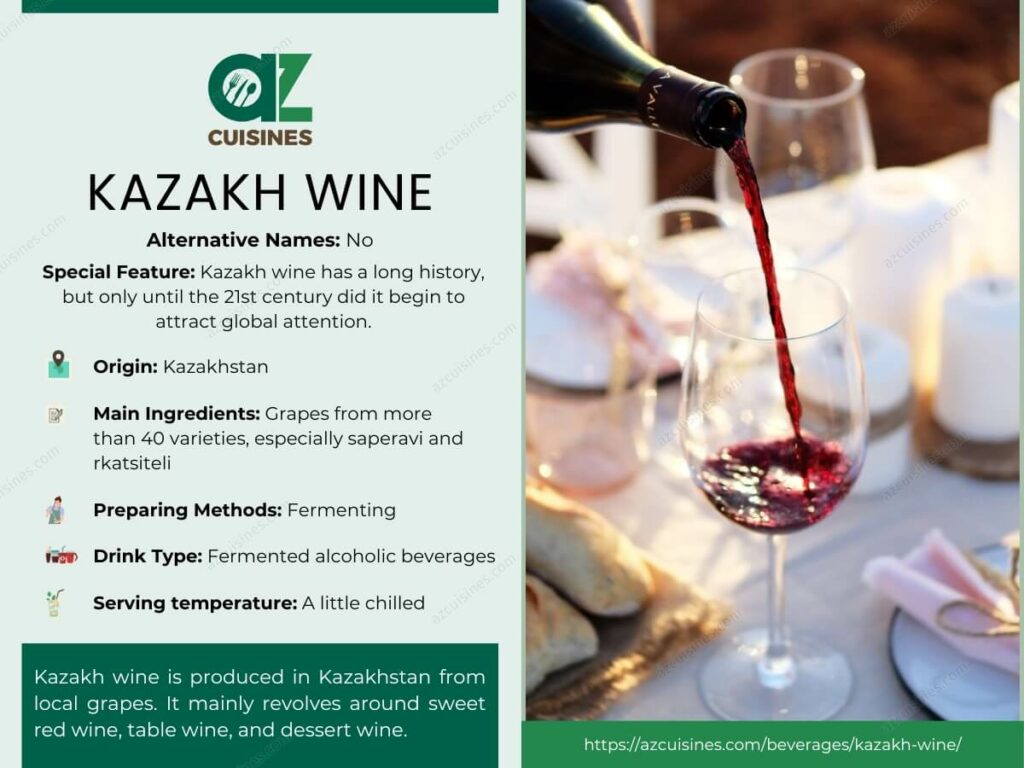#7 in Kazakhstan
Kazakh Wine: Basic Information
Pronunciation
Alternative Name(s)
Drink Type
Mealtime
Popular Variations
Kazakh Wine: Ingredients and Preparation
Main Ingredients
Main Preparing Method
Preparation Process
Kazakh Wine: A Deep Dive
Cultural Significance
Taste
Texture
Aroma
Color
Serving Style
Serving Temperature
Accompaniment
Occasions
Calories
Popularity
Popular Similar Drinks
Popular Dining Area
Kazakh wine refers to wines produced in Kazakhstan, with sweet red wines as local favorites. Table wine and dessert wine account for the largest proportion.
The Central Asian country has a long wine-making tradition that has been through many ups and downs.
Kazakh wine was first mentioned in the 7th century, produced based on techniques from Europe and neighboring countries in Central Asia. By the 13th century, however, Kazakh wine production stopped for many reasons.
The local wine industry was revived in the 1940s but went downhill after the breakup of the Soviet Union.
Now, Kazakh wine is making a comeback, taking advantage of its excellent location. The country’s major wineries lie in the southern half, especially in the Almaty region.
This place has a continental climate with a significant disparity between daytime and nighttime temperatures, producing superior grapes and killing off harmful fungi.
While Kazakh wine is often enjoyed domestically or exported to Russia, many countries like the UK, the US, and Japan are developing a taste for it.
Stay tuned, and I will tell you everything there is to know about wine in Kazakhstan, such as the main grape varieties, the best wine brand in the country, the pros and cons of Kazakh wine, and answers to frequently asked questions about local wine.
Key Points
What Are the Main Grape Varieties in Kazakhstan?
Kazakh vineyards cultivate more than 40 grape varieties, with saperavi and rkatsiteli as the most popular options.
Other common varieties in Kazakhstan are bayan shirey, muscat ottonel, cabernet franc, cabernet sauvignon, aligote, aleatico, pinot noir, riesling, etc.
Saperavi is a red grape variety resulting in medium to full-bodied wine with high acidity and high tannin, with the subtle aromas of tobacco and blackberries.
Meanwhile, the white grape rkatsiteli produces light-bodied, high-acidity wine with little tannin and herbaceous notes.
Those two local grape varieties are used extensively in many products from Kazakhstan’s most famous wine brand.
What Is the Best Wine Brand in Kazakhstan?
The best wine brand in Kazakhstan is Arba Wine, headed by Zeinulla Kakimzhanov, who plays an important role in revitalizing the country’s wine scene.
The winery is located at Assa Valley, east of Almaty. Below are some recommended Kazakh wines.
- Arba Wine ‘Lagyl Arba’ Saperavi Reserve
- Arba Wine ‘Sary Arba’ Rkatsiteli
- Arba Wine Kyzyl Bastau
- Arba Wine Kyzyl Arba Cabernet Franc
- Arba Wine ‘Ak Arba’ Riesling
Do you want to try those wines? But before doing so, let’s check out the advantages and disadvantages of Kazakh wine.
Pros and Cons of Drinking Kazakh Wine
Here is a brief list of the strengths and weaknesses of Kazakh wine:
Pros
Cons
After learning about these pros and cons, you can deepen your understanding of Kazakh wine by reading on to discover the answers to common queries about local wine.




Adam Sam
Senior Food and Drink Editor
Expertise
Food Writer & Recipe Developer, Recipe Tester, Bartender, Cooking-video Maker, Editor In Chief
Education
Adam Sam, an experienced food writer and recipe developer, is passionate about blending diverse culinary traditions, national dishes, and innovative beverages, showcasing his proficiency in both traditional and modern recipe testing.
As the Editor-in-Chief, he elevates culinary content from street food to fine dining, focusing on Western cuisine and types of drinks at azcuisines.com, and is professional in creating engaging cooking videos that simplify complex dishes and ingredients.
His passion for food is evident in his writing, where he uniquely merges various cultures, traditions, and contemporary trends, skillfully combining classic recipes with modern cooking methods.